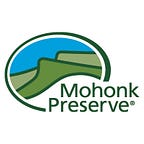Research Report #20 — The Shawangunk Sky Island-A Research Concept
For many years scientists and naturalists have been studying and observing the flora and fauna of the Shawangunk Ridge. Foremost among them was Daniel Smiley, for whom Mohonk Preserve’s Daniel Smiley Research Center is named. Dan wrote numerous reports summarizing his observations on various topics. This regularly occurring series will feature some of these reports; some hold tremendous scientific value today and just await an interested researcher to follow up, others showcase a quirky sense of humor or highlight an oddity of nature.
Read the report: The Shawangunk Sky Island-A Research Concept. July 1988. Daniel Smiley.
A note from Paul C. Huth, Director of Research Emeritus: I can well remember in the mid-1980s, how impressed Daniel Smiley was after his visit at Mohonk with a Pacific Ocean Island ecologist whose research involved oceanic island species dynamics, genetic diversity, ecosystem influences both positive and negative, and resource limitations.
Later, Dan read an article in the March 1988 issue of Harper’s Magazine, focussing on tropical rain forest clear cutting for timber harvest, leaving only “islands” of intact but completely isolated remnants of the once original lush forest. As a result, he began to focus on this island concept and if some island terminology could be applied to the Shawangunk ridge. Considering, for example, that this local ridge ecology is sharply defined by “….geology, climate, flora, and fauna different from the valleys on either side….(and) different from the nearby Catskill Mountains.” In discussion of potential island isolation dynamics with his good friend Dr. Vincent J. Schaefer, Vince suggested that the Shawangunk ridge might be called “a sky island.” And so the connection was made.
Since Dan had been observing and documenting individual species and their phenology records, dramatic changes in cultural history, and as he called it, “signs of stress” for an increasing number of Shawangunk plants and animals for over 60 years, he was in a good position to extrapolate concepts. For example, he defined the summit ridge as containing 25,000 acres, about 1/3 the size of Long Island. It’s “shoreline” was the 200 foot USGS contour boundary, about 40 miles around, from Rosendale on the northeast to Cragsmoor on the southwest, and following both valleys in between. He was clear it contained both public and private land.
As “amphibious” organisms, Dan considered those species which lived on both sides of the “shoreline” and move back and forth, like “mustard, honey bees, song sparrows and deer.”
An example of a “barrier reef” might be the Humpo Marsh. “Driftwood” might be species that showed up for a short time and left, but may reappear again, like the Fish Crow. “Erratics,” Dan felt were left over from the last ice age, “but are not subject to occurring again, unless or until there is a new ice sheet.”
As for “waves….beating on the shore of our Sky Island….would include: people, cars, litter, housing, (and) hydrologic problems.” “Clouds” floating by, possibly leaving behind their affects, would include such things as “weather systems, ultraviolet light, acid rain, (and) volcanic dust,” like that arriving from Mount St. Helens on May 18, 1980.
As for “tourists,” that show up for a short time and left, but might visit again, Dan considered “White Pine Blister Rust, Barn Rats, rabies(?), bird migrants and seasonal visitants, (and) acid rain.” “Immigrants” to the Sky Island, “….came and reproduced and stayed,” and would include “reed grass, gypsy moth, gold fish, chestnut blight, Lyme tick, House Finch, (and the) Smiley Family.” “The Smileys came for a day in 1869 and have been here for 120 years and continue to be a part of the Shawangunk Sky Island ecosystem.” “Emigrants-after a time of residence they went elsewhere,” include the “fisher, business apprentices (including interns), research reports, and painters (starting with the Hudson River School) and photographers.”
At the end of this report, Dan thought about “Our Research Opportunity and Challenge.” He correctly postulated in 1988 that the Shawangunk Sky Island would become even more strongly separated “from the ocean of valley agriculture and housing development.” Dan felt one challenge was to define and protect enough land, diverse habitats, and corridors as to allow for continued species survival and interaction. He said….“examples of these interactions and stresses are being studied at the Elms (now Daniel Smiley Research) Center. The longer these studies continue, the more value they will have in the stewardship and management planning for the Shawangunk Sky Island.” “As we detect changes in progress, or impending changes, the question becomes: ‘What is causing the change and do we want to accept the change?’ If the answer is ‘no,’ then we had best consider if there is an alternative path for change.”
A nice tie in and validation of Dan’s Sky Island concepts, occurred in the early 1990s, as Preserve Research Associate, Dr. Paul F. Steblein, then of the New York State Museum, Biological Survey, chose the Shawangunk ridge for his study of the diversity of New York State mammals. Paul selected the Shawangunks not only as a exceptional natural area in southeastern New York, but also because it represented a “terrestrial island,” like those “in tropical rainforest ecosystems….as if they they were surrounded by water, species in the Shawangunks can no longer easily inter-breed with those in adjacent areas like the Catskills due to such human developments as roads and buildings.”
The Sky Island report was first issued in 1988 as Mohonk Preserve Historical/Cultural Note №31.
Read the report: The Shawangunk Sky Island-A Research Concept. July 1988. Daniel Smiley.
